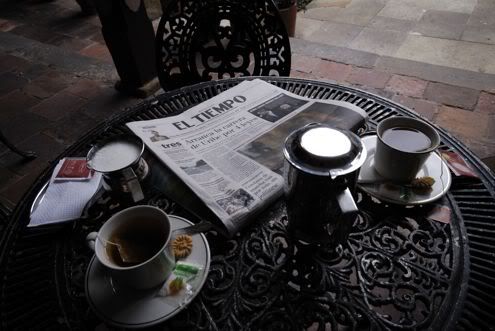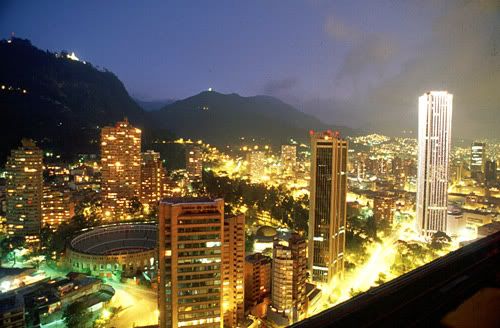|
Bogota...Bogota is the capital, and largest city, of Colombia. It is also designated by the national constitution as the capital of the department of Cundinamarca, even though the city now comprises an independent Capital district and no longer belongs administratively to that department. Bogota is the most populous city in the country, with an estimated 7,304,384 residents as of 2009. Its metropolitan area, which includes municipalities such as Chía, Cota, Soacha, Cajicá and La Calera, had an estimated population of 8,566,926 in 2009. When you look at the size of land area, this is the largest city in Colombia, and one of the biggest of Latin America. Bogota ranks amongst the thirty largest cities of the world and it is the third-highest capital city in South America (after La Paz and Quito) at 2,625 metres (8,612 ft) above sea level. Bogota Colombia is 2640 metres (8661 ft) above sea level. So if you're comparing it to North American cities....Denver, Colorado is nicknamed the Mile-High City because its official elevation is exactly one mile (1.6 km) or 5,280 feet (1,609.344 m) above sea level. Climate...Bogota weather is a subtropical highland climate. The average temperature is 14.0 °C (57 °F), and it varies from 3 to 25 °C (37 to 77 °F) during the course of the day. Dry and rainy seasons alternate throughout the year. The driest months are December, January, February and March. The warmest month is March, bringing a high of 19.7 °C (67.5 °F). The coolest weather at night occur in January, with an average of 5.4 °C (41.7 °F) in the city; temperatures can fall below freezing in the nearby towns causing frosts and fog in early morning, with the lowest recorded temperature within the city being -7.2 °C (19.0 °F).[10] in February 2007. The official highest recorded temperature is 24.9 °C (77 °F) reached in January 1992 and March 1995.[11] Rain...The rainiest months are April, May, September, October and November, in which typical days are mostly overcast, with low clouds and some winds, bringing the high temperatures of 18 °C (64 °F) and lows of 7 °C (45 °F). June and July are usually rainy periods and August is sunny with high winds. Hailstorms are very common during the rainy season, and at times can be very strong, especially in October. The days are mild or cool and nights can get somewhat cold due to the city having mild winds in the night all year round. While temperatures are relatively consistent throughout the year, weather conditions can change dramatically during the course of a single day. Climatic conditions are irregular and variable due to the El Niño and La Niña climatic phenomena which are responsible for pronounced climatic changes. This makes the city's weather unpredictable; sunny mornings can turn out into a severe-storm afternoon (something commonly referred as "Sol de Lluvia" (literally, "Rainy Sun"). Bogota Lay-Out...Street arrangement of Bogota based on the Cartesian coordinate system.(BIGGER MAP) North is to the right.Bogota has 20 localities, or districts, forming an extensive network of neighborhoods. Areas of higher economic status tend to be located to the north and north-east, close to the foothills of the Eastern Cordillera. Poorer neighborhoods are located to the south and south-east, many of them squatter areas. The middle classes usually inhabit the central, western and north-western sections of the city.
Downtown Bogota...The urban layout in the center of the city is based on the focal point of a square or plaza, typical of Spanish-founded settlements, but the layout gradually becomes more modern in outlying neighborhoods. The current types of roads are classified as calles (streets), which run perpendicular to the Cordillera, with street numbers increasing towards the north, and also towards the south (with the suffix "Sur") from Calle 0. Carreras run parallel to the hills, with numbering increasing as one travels east or west of Carrera 1 (with the suffix "Este" for roads east of Carrera 0). At the south-east of the city, the addresses are logically sur-este. Other types of roads more common in newer parts of the city may be termed "Eje" (Axis), "Diagonal" or "Transversal". The numbering system for street addresses recently changed, and numbers are assigned according to street rank from main avenues to smaller avenues and local streets. Some of Bogotá's main roads, which also go by a proper name in addition to a number, are: * Norte-Quito-Sur or N.Q.S. (North Quito South Avenue, from 9th road at north following railway to 30th road Avenue, or Quito City Avenue, and Southern Highway) * Autopista Norte-Avenida Caracas (Northern Highway, or 45th road, joined to Caracas Avenue, or 14th road) * Avenida Circunvalar (from downtown following hillside on eastern hills going to La Calera, mostly the 1-este (1st-east)) * Avenida Suba (60th transversal from 100th street to the Suba Hills; 145th street from Suba Hills westward) * Avenida El Dorado (El Dorado Avenue, or 26th street) * Avenida de las Américas (Americas Avenue, from 34th street at east to 6th street at west) * Avenida Primero de Mayo (May First Avenue, or 22nd (partly 20th too) south street) * Avenida Ciudad de Cali (Cali City Avenue, or 86th road) * Avenida Boyacá (Boyacá Avenue, or 72nd road) * Autopista Sur (Southern Highway) Demographics...The largest and most populous city in Colombia,Bogota has 8,566,926 citizens in its metropolitan area (2009 census), with a population density of approximately 3912 inhabitants per square kilometer. 47.5% of the population are male and 52.5% women. 99.5% of households have electricity service, while 98.7% have water service and 87.9% have telephone service. However, 32.6% of citizens were living in poverty (living on less than US$2 a day) in 2005. In Bogotá, as in the rest of the country, the acceleration of the urbanization process is not only due to industrialization, since there are complex political and social reasons such as poverty and violence which led to migration from rural to urban areas throughout the twentieth century. This has led to an exponential growth of population in urban areas creating misery belts in their surroundings. A dramatic example of this is the number of displaced people who have arrived in Bogotá. According to the Consultancy for Human Rights, Codhes, in the period from 1999 to 2005 more than 260,000 people arrived in Bogotá as a result of displacement, about 3.8% of the total population of Bogotá.
The racial composition of the city's population includes people of Mestizo origin (those of mixed Amerindian and European descent), in addition to Europeans, mostly Spaniards, and other European ethnic groups. It has a large Middle Eastern population, made up mostly of Lebanese and Syrian immigrants. The Afro-Colombian population in Bogotá is smaller than cities along the coast such as Cartagena, where Colombians of African descent have historically resided. Crime...Bogotá has gone to great lengths to change its crime rate and its image with increasing success after being considered in the mid-90s to be one of the most violent cities in the world. In 1993 there were 4,352 intentional homicides at a rate of 81 per 100,000 people; in 2007, Bogotá suffered 1,401 murders at a rate of 19 per 100,000 inhabitants. Compare that to Chicago, Illinois (15.65 per 100,000.) According to a 2011 article in The New York Times 'street muggings and thefts on public transportation have surged since 2007', leading certain commentators to declare a crisis of security in the city. According to several polls around 72% of the inhabitants say they have been victims of violent crime in 2010 and 2011. A guy I know from the Internet & some of you know too, tells a story of his mugging one night. Rubio is smart enough to know though terrible, he doesn't hold it against Colombia or it's people....like anywhere you have thugs looking for an opportunity. The key is, take the opportunity away in your movements in and around the city.
Socioeconomical Stratums and Billing...Energy and sewer bills are stratified based on the location of owner's residence and income, with the intended purpose that wealthier branches of society subsidize the energy bills of the poorer. Most of Colombia if not all are divided into six socio-economic "estratos" (strata):
Shopping malls...Bogotá's shopping malls are great places to hang out & people watch, and grab a snack to eat. The malls in Colombia blow me away in comparison to the U.S. It's just wild to me the small strore spaces & little inventory on the shelves or for display. Anyway here are a few mall to get lost in & if anybody has a review or a mall I'm missing...send me a message in the form below.

Radio/Television......stay tuned links coming soon! Fotos of Bogota, Colombia...
Click HERE to see some pictures of Bogota. If you have some to share please let us know so we can put them up! Keep us bookmarked as we're always adding new pictures!
|
Hola! :-)
Hello! This is Todd & Johana. Welcome to Colombia-Travel-Magazine. Like you, we both love Colombia & all it has to offer.
Thank you for visiting our Internet home! Add your voice to the world by telling others your stories, tips, likes, & news by easily sending C-T-M the form located at the bottom of this page.
Let's join together and erase all the false & negative stereotypes Hollywood has presented.
Come on, lets have some fun & share our good times with others!
We work on all our Sites from home. They are our main source of income...a great income!
Click the Site Sell link below right now to see how you too can work from home! Any questions send us an email & we'll try to help you along. We'll help you achieve Internet success!
eMAIL US HERE!













